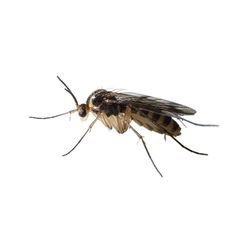Gnats

Identification
Gnats come in various colors, from brown, black, gray and yellow.
Gnats are as small as 1 millimeter, while others can be up to 13 millimeters long.
Gnat’s overall body structure is similar to other family members, including mosquitoes and midges. Gnats have six legs, two wings, and a pair of antennae that help them detect food sources and potential mates.
Get A Free Quote
We are affordable Pest Control Service in GTA & Surroundings Areas.
Body Structure
Gnats have slender bodies with a narrow thorax and abdomen. They also have large compound eyes that allow them to perceive movement quickly, which helps them avoid predation. Unlike mosquitoes, gnats do not possess a proboscis for feeding on blood – instead, they feed on nectar or other sugary substances by using their mouthparts located at the front of their head.
Discover the secrets to a gnat and Drain flies-free home with our expert tips on efficient pest control, ensuring a serene and comfortable living space.
Habitat, Diet, Lifecycle of Gnats
Gnats are small, flying insects that are commonly found in many regions of Canada. These insects are known for their annoying presence and buzzing sound, but they play an important role in the ecosystem as a food source for other creatures. We will explore the habitat, diet, and lifecycle of gnats in Canada.
Habitat: Gnats are common in wet and humid environments, such as marshes, swamps, and moist forests. They are also found in urban areas, where they can breed in standing water, including drains, gutters, and containers. In Canada, gnats are most active during the spring and summer months when the weather is warm and humid.
Diet: Gnats are primarily herbivores and feed on nectar, plant sap, and fruit juices. They also feed on fungi, algae, and decaying organic matter. Some gnats are predators and feed on other insects, including aphids and other small flies.
Lifecycle: The gnats’ lifecycle begins with eggs laid in moist soil, rotting vegetation, or stagnant water. The eggs hatch into larvae, which are worm-like and feed on organic matter in their environment. After several weeks, the larvae pupate and emerge as adult gnats.
The adult gnats mate and lay eggs, and the cycle begins again. The entire lifecycle of gnats can take anywhere from two to four weeks, depending on the species and environmental conditions.
Residential Pest Control Service
Customized pest control treatments can be used to safeguard your living space against bothersome pests and ensure that they don’t become a nuisance in your home.
Control Strategies for Gnats: How can you get rid of them?
Gnats can be a pesky problem in both indoor and outdoor spaces. However, you can use several control strategies to get rid of them. One option is eliminating their breeding grounds by removing any standing water sources in and around your home, such as plant saucers or bird baths. This will prevent gnats from laying eggs and reproducing.
Another strategy is to use natural repellents. These oils can be diluted with water and sprayed in areas where gnats are present. Alternatively, sticky traps can also be used to catch gnat’s mid-flight.
Lastly, chemical insecticides specifically designed for gnats are available for those who prefer a more aggressive approach. These products should only be used according to instructions on the label and with adequate precautions taken to protect yourself, pets, and other household members from exposure. Using one or a combination of these control strategies consistently over time, you can effectively eliminate gnats in your home or outdoor space.
